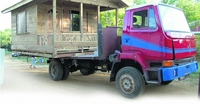House Hauling
Published: Sunday | September 20, 2009

WESTERN BUREAU: RELOCATING TO a new home comes with its challenges. Packing, trucking and unpacking. Moving a house by truck, however, is a whole different operation.
In Westmoreland, it is not unusual to see trucks navigating roadways and negotiating tight corners with their cargo of traditional wooden houses, which scatter the landscape primarily along the stretch of road from Big Bridge through Little London into Negril.
"We carry these houses to as far away as Trelawny," says Rugby Smith, removal expert of Broughton, Westmoreland.
Smith, co-owner of Derval and Brother Ltd, has been involved in landscaping, construction and house moving for the past 22 years.
He said that in Westmoreland, owners of these houses tend to relocate on a regular basis as their land leases expire.
Nowadays, Smith uses a 1989 six-wheeler Leyland Freighter truck to transport the buildings around the country, but he recalls the day when he acquired his first vehicle - a 1965 Bedford - which he bought from his cousin and which served its purpose up until November last year.
A former body repairman who once worked in Grand Cayman, Smith explained that he had to modify to his current 10-tonne flatbed tipper carrier for house-hauling purposes.
reinforced
"The chassis of the truck had to be reinforced," he said and explained that the modification process involved bolting another chassis on to the existing one so it can carry the weight of the wooden houses. The vehicle is fitted with a 402 turbo-charged engine as well as a ZF six-speed gearbox and can carry a house measuring 14 feet by 30 feet.
How is the house moved?
"One end of the house would be jacked up high enough for the truck to back up underneath it while the body is tipped backwards. Then the house is rolled on to two pieces of pipes measuring five or six inches in diameter which are placed on the truck," Smith said. However, he said he and his team members made sure not to roll the house all the way on to the flatbed, making it easier to roll off the house on reaching the destination.
"About four feet or five feet of the foundation of the house is left hanging off the flatbed truck," he continued.
The house mover said the structure is then secured to the rollers and the flatbed with ropes, using bandage lock knots.
four men
According to Smith, the houser-moving operation requires at least four men: a driver; a watchman, who looks out for low-hanging utility wires and tree limbs and two 'stick men', who sit on either side of the truck and use long bamboo sticks to hoist the overhangs to make sure they do not get caught in the roofs of the houses.
"We can travel about 15 miles per hour ... and even faster when travelling in the sugar-cane belts of Westmoreland and Trelawny because the utility poles tend to be higher in those parts," he said.
Smith was uncomfortable with discussing his house-moving rates, but was only willing to say that he "charged based on the distance that we have to travel".
"We always offer a reasonable rate because if the homeowners had money they would not have to relocate as often as they do," he concluded.
Smith, who prides himself in never being defeated by a challenge said: "No matter how badly damaged a house is, we always find a way to relocate it safely."
